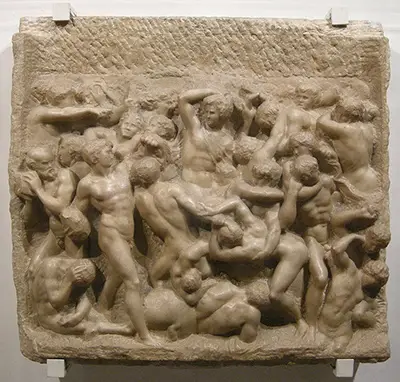Michelangelo used cheaper marble instead of bronze as it was not a commissioned piece but a work for himself. It was created without the use of a bowdrill for the finer detail, his first such work.
It is left with the marks of the subbia chisel remaining on the surface in the “non finito” technique which has lead scholars to debate whether Michelangelo was finished with the work, or intended to come back to it at a later stage.
The contemporary biographer Scigliano notes that he had plenty of time to do so, had he wished. Michelangelo considered this sculpture as one of his best early works.
The sculpture was inspired by a bronze relief by Bertoldo di Giovanni that was in the Medici collection. The idea was suggested to him by scholar and poet Poliziano who was at the Medici home with Michelangelo and told him of the story.
The sculpture features the mythic battle between the Lapiths and the Centaurs. This was a popular subject in ancient Greece and Rome. The battle is depicted on the Parthenon, at Zeus’ temple at Olympia and on Roman sarcophagi.
The battle takes place at the wedding of Pirithous, the king of Lapith. The Centaurs are descended from Pirithous’ brother, Centaurus, who fathered a savage race of half human half horse offspring after a union with a wild mare. After the death of his father Ixion, Pirithous succeeded the throne but furious Centaurus wanted to share the rulership between them.
There was long history of clashes between the Lapith and the Centaur, so to signal his good intent toward them Pirithous invited them to the wedding. Some centaurs were affected by the wine as they were unused to it and when the bride, Hippodamia, was presented to the guests Eurytion and others attempted to kidnap her and the other women in attendance. There was an immediate skirmish which dragged into a year long war before the Centaur were defeated and exiled from Thessaly.
Centaurs are associated in classical literature with the uncivilised side to human nature, sculptors from the school of Pheidias see this event as a battle between order on one side and chaos on the other, or the civilised Greeks and the Persian “barbarians”. Another interpretation is that the battle represents the victory of reason over brutish, animal force. Michelangelo depicts the combatants using rocks to fight. Caeneus the famous Lapith, is invulnerable to weapons, so the Centaurs crush him with rocks and tree branches.
The figures in the sculpture are fluid and alive. They are carved in complicated overlapping, struggling positions. Each figure is individual, even down to the facial features and expressions. Each pose has evidently been considered and designed by Michelangelo separately. The dynamic position of each character gives the sculpture a vigorous mood, it is full of activity and energy. There is a chaotic, frantic tone as the combatants struggle together in battle. Each individual is so well developed that it is almost possible to imagine that the rest of the form is intact though unseen within the marble structure.
The musculature definition and detail along with movement of each fighter display Michelangelo’s mastery of the human form even at this early age. Michelangelo had a great love for the human body, and most figures are rendered only from the waist up. This has obscured the identity of the centaur fighters, and only one is clearly identifiable. He is seen at the bottom, in the centre, where his leg and hoof are seen extended between the feet of the individual standing over him. Michelangelo has achieved the appearance of depth to the sculpture by contrasting areas of shadow with highly polished figures.


